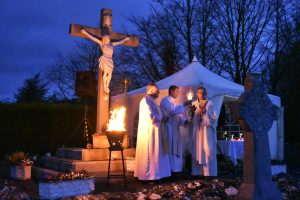CONFERRING OF THE PALLIUM ON ARCHBISHOP KIERAN O’REILLY
CATHEDRAL OF THE ASSUMPTION, THURLES SUNDAY OCTOBER 4TH 2015
On the 29th. June 2015 – changes were made to the public ceremony of investiture of the Pallium.
Newly appointed Archbishops would receive the blessed Pallium from the Holy Father, but the investiture would no longer take place in the Vatican.The Pallium would be conferred on the Metropolitan Archbishop in his own Diocese by mandate of the Holy Father, by the Pope’s representative, the Papal Nuncio, in the presence of, and with the participation of the Bishops of the Cashel Province and the people of the Diocese.In this way the ceremony will continue to symbolize communion between the See of Peter and the Successor of the Apostles and those who are chosen to carry out the episcopal ministry as Metropolitan Archbishop of an Ecclesiastical Province, and it will feature the participation of the local Church in an important moment of its life and histo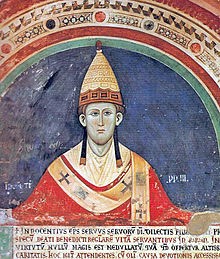 ry
ry
Pope Innocent III (depicted wearing the pallium)
in a fresco
at the Sacro Speco Cloister (13 Cent.)
THE PALLIUM
The Word Pallium derives from Latin signifying a coverlet, a mantle or a small cloak. In the Western Church, the Pallium has been for centuries a circular band of finely woven white lamb’s wool (from sheep raised by Trappist monks) about two inches wide, worn around the neck, having two pendants, one hanging down the front and the other behind. The pendants are approximately two inches wide and twelve inches long, and are weighted with small pieces of lead covere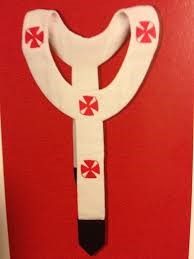 d with black silk. On the Pallium are six crosses one on each shoulder, one at the front another at the back, and one on each pendant. The crosses on the Pallium of the Pope are red, those on the Pallium of an Archbishop are black. This Pallium, the Pope’s Pallium, signifies the communion between the Bishop of Rome and the Metropolitan Archbishops he has appointed to oversee the Church.
d with black silk. On the Pallium are six crosses one on each shoulder, one at the front another at the back, and one on each pendant. The crosses on the Pallium of the Pope are red, those on the Pallium of an Archbishop are black. This Pallium, the Pope’s Pallium, signifies the communion between the Bishop of Rome and the Metropolitan Archbishops he has appointed to oversee the Church.
St. Simon of Thessalonica declared, “The Pallium signifies the Saviour who
finding us like lost sheep puts us on His shoulders, and taking on our own human likeness in the Incarnation He glorified it, with His death on the cross He offered us to the Father, and with the resurrection He exalted us.”
The Pope’s Pallium is slightly different from those he confers on Archbishops. The red silk crosses remind the wearer of the five wounds of Christ crucified. Three pins are inserted into three of the
crosses to remind him of the nails that caused these wounds in each of the hands and feet of Christ. All pallia have the end tips of the garment embroidered in black silk, reminiscent of the feet of the lambs the Good Shepherd laid down his life for, so that they may walk safely on the path of life.
The plain white wool of the Pallium also serves to remind the wearer that all power comes from t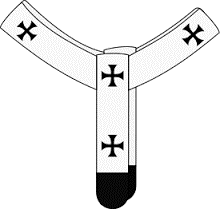 he Lamb of God. The lamb is often held as a symbol of peace the Pallium too is a symbol of the mission to uphold the peace and unity of the Church and to be an apostle of the Prince of Peace.
he Lamb of God. The lamb is often held as a symbol of peace the Pallium too is a symbol of the mission to uphold the peace and unity of the Church and to be an apostle of the Prince of Peace.
St. Agnes
Virgi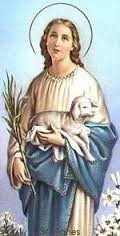 n-Martyr
n-Martyr
Feast Day January 21st
Though of simple design the Pallium is a vestment rich in significance.
Each year in the Convent of St Agnes, on the Feast of St Agnes, two lambs, whose wool is destined for the making of the Pallia, are presented to the
faithful for viewing. The lambs rest in two separate baskets, one decorated with red flowers, signifying martyrdom, the other with white flowers signifying virginity. Then, taken in procession to the Altar at the beginning of Mass they are blessed with Holy Water and incense by the Abbot General of the Lateran Canons Regular. Immediately after the Blessing, the lambs are taken to the Pope at the Apostolic Palace for him also to bless them. After being presented and blessed by the Pope the lambs are taken to be cared for by the Benedictine nuns whose house is built on the site of St Cecilia’s house.
They stay in the garden of the Convent until a short time before Easter when they are shorn of their wool. Every Pallium is woven to include some of the wool of the two lambs blessed by the Pope. Once made the Pallia are placed in a silver gilt casket in the Confessio of the Vatican Basilica, which is the space directly below the High Altar of St. Peter’s and is also where St. Peter’s bones rest. Having been placed so near the tomb of St. Peter the Pallium becomes a rel-ic of the Apostle – having rested in that sacred place.
On the Feast of SS Peter and Paul, 29th, June, the Pallia are taken from their rest-ing place to the Holy Father for him bless and present to the newly appointed Archbishops. They will then be conferred with the Pallium in their own Diocese.
Information sourced from :
The Pallium – EWTN.com
www.ewtn.com/library/CHISTORY/PALLIUM.H
Pallium – Wikipedia, the free encyclopaedia

